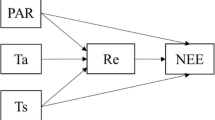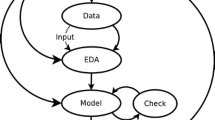Abstract
Structural equation modeling (SEM) holds the promise of providing natural scientists the capacity to evaluate complex multivariate hypotheses about ecological systems. Building on its predecessors, path analysis and factor analysis, SEM allows for the incorporation of both observed and unobserved (latent) variables into theoretically-based probabilistic models. In this paper we discuss the interface between theory and data in SEM and the use of an additional variable type, the composite. In simple terms, composite variables specify the influences of collections of other variables and can be helpful in modeling heterogeneous concepts of the sort commonly of interest to ecologists. While long recognized as a potentially important element of SEM, composite variables have received very limited use, in part because of a lack of theoretical consideration, but also because of difficulties that arise in parameter estimation when using conventional solution procedures. In this paper we present a framework for discussing composites and demonstrate how the use of partially-reduced-form models can help to overcome some of the parameter estimation and evaluation problems associated with models containing composites. Diagnostic procedures for evaluating the most appropriate and effective use of composites are illustrated with an example from the ecological literature. It is argued that an ability to incorporate composite variables into structural equation models may be particularly valuable in the study of natural systems, where concepts are frequently multifaceted and the influence of suites of variables are often of interest.
Similar content being viewed by others
References
Belovsky GE, Botkin DB, Crowl TA, Cummins KW, Franklin JF, Hunter ML, Joern A, Lindemayer DB, MacMahon JA, Margules CR and Scott MJ (2004). Ten suggestions to strengthen the science of ecology. Bioscience 54: 345–351
Blalock HM (1964). Causal inferences in nonexperimental research. University of North Carolina Press, Chapel Hill
Bollen KA (1984). Multiple indicators: internal consistency or no necessary relationship. Qual Quant 18: 377–385
Bollen KA (1989). Structural equations with latent variables. John Wiley & Sons, New York
Bollen KA (1990). Overall fit in covariance structure models: two types of simple size effects. Psychol Bull 107: 256–259
Bollen KA and Lennox R (1991). Conventional wisdom on measurement: a structural equation perspective. Psychol Bull 110: 305–314
Bollen KA and Ting K (2000). A tetrad test for causal indicators. Psycholo Methods 5: 3–22
Diamantopoulous A and Winklhofer HM (2001). Index construction with formative indicators: an alternative to scale development. J Marketing Res 38: 269–277
Edwards JR (2001). Multidimensional constructs in organizational behavior research: an integrative analytical framework. Organ Res Methods 4: 144–192
Fayers PM and Hand DJ (2002). Causal variables, indicator variables and measurement scales: an example from quality of life. J R Stat Soc Ser A 165: 233–261
Grace JB (2003). Examining the relationship between environmental variables and ordination axes using latent variables and structural equation modeling. Chap 7. In: Pugesek, BH and Tomer, A (eds) Structural equation modeling, pp 171–193. Cambridge University Press, Cambridge
Grace JB (2006) Structural equation modeling and natural systems. Cambridge University Press
Grace JB and Bollen KA (2005). Interpreting the results from multiple regression and structural equation models. Bull Ecol Soc Am 86: 283–295
Grace JB, Bollen KA (2006) The interface between theory and data in structural equation models. USGS Open-File Report. Available at www.nwrc.usgs.gov/about/web/j_grace.htm
Heise DR (1972). Employing nominal variables, induced variables and block variables in path analyses. Sociol Method Res 1: 147–173
Hipp J, Bauer DJ and Bollen KA (2005). Conducting tetrad tests of model fit and contrasts of tetrad-nested models: a new SAS macro. Struct Equ Model 12: 76–93
Jarvis CB, MacKenzie SB and Podsakoff PM (2003). A critical review of construct indicators and measurement model misspecification in marketing and consumer research. J Consum Res 30: 199–218
Johnson ML, Huggins DG and deNoyelles F Jr (1991). Ecosystem modeling with LISREL: a new approach for measuring direct and indirect effects. Ecolo Appl 1: 383–398
Laughlin DC, Grace JB (2006) A multivariate model of plant species richness in forested systems: old-growth montane forests with a long history of fire. Oikos 114:60–70
Levins R (1968). Evolution in changing environments. Princeton University Press, Princeton
MacCallum RC and Browne MW (1993). The use of causal indicators in covariance structure models: some practical issues. Psychol Bull 114: 533–541
Mitchell RJ (1992). Testing evolutionary and ecological hypotheses using path analysis and structural equation modelling. Funct Ecol 6: 123–129
Muthén LK and Muthén BO (2004). Mplus user’s guide. Muthén and Muthén, Los Angeles
Pugesek BH and Tomer A (1996). The Bumpus house sparrow data: a reanalysis using structural equation models. Evol Ecol 10: 387–404
Pugesek BH, Tomer A and Eye A (2003). Structural equation modeling. Cambridge University Press, Cambridge
Shipley B (2000). Cause and correlation in biology. Cambridge University Press, Cambridge
Spirtes P, Glymour C and Scheines R (1993). Causation, prediction, and Search. Springer-Verlag, New York
Verheyen K, Guntenspergen GR, Biesbrouck B and Hermy M (2003). An integrated analysis of the effects of past land use on forest herb colonization at the landscape scale. J Ecol 91: 731–742
Weiher E, Forbes S, Schauwecker T and Grace JB (2004). Multivariate control of plant species richness in a blackland prairie. Oikos 106: 151–157
Williams LJ, Edwards JR and Vandenberg RJ (2003). Recent advances in causal modeling methods for organizational and management research. J Manage 29: 903–936
Wright S (1921). Correlation and causation. J Agr Res 10: 557–585
Wright S (1968). Evolution and the genetics of populations, vol. 1: genetic and biometric foundations. University of Chicago Press, Chicago
Author information
Authors and Affiliations
Corresponding author
Rights and permissions
About this article
Cite this article
Grace, J.B., Bollen, K.A. Representing general theoretical concepts in structural equation models: the role of composite variables. Environ Ecol Stat 15, 191–213 (2008). https://doi.org/10.1007/s10651-007-0047-7
Received:
Revised:
Published:
Issue Date:
DOI: https://doi.org/10.1007/s10651-007-0047-7




